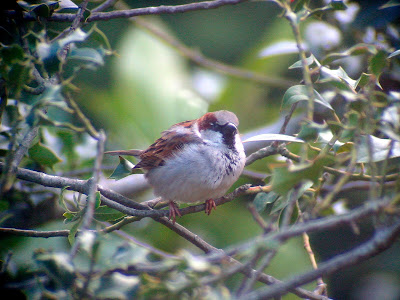What’s so special about House Sparrows?
Walking home from work this evening, I was struck by the rich numbers of House Sparrows I saw on the way. Now I know the humble House Sparrow has come top of the Big Garden Birdwatch this year, which, on one hand is clearly good news, but the worrying fact remains, this bird is collectively – across the UK and chunks of the world – in serious decline. In fact, The British Trust for Ornithology (BTO) put it on its Red List back in 2002.
50 odd years ago, the sparrow population was recorded at around 10 million. By the mid 70’s it was approximately 25 million but after that, it fell out of the sky and crashed during the 1990’s leaving the population by 2000 down by 65%.
So what has done this little fellow in? There are of course a number of valid theories including the moderisiation of farming through more effective grain storage, tighter housing of livestock and feed and cereal hygiene that requires farm building to be watertight or rather, 'sparrow-tight' reducing their opportunity to nest. Agriculture’s obsession with fertilisers and pest controls have reduced insect populations and reduced plant food sources for the birds but doesn’t our Weetabix taste great?
Now, it’s in towns and cities that the House Sparrow is facing its greatest threat. Many houses are now built either without eaves or they have PVC equivalents, rotten wooden ones made perfect nest sites. Front and some back gardens are concrete carpets or covered in decking which really only suits rodents. A gardener’s world is now all about neat and tidy shrubberies with shiny new sheds. No spiders, grubs or worms in sight, more like gravel or bark, raised beds and some metallic water feature.
Couple this with the possibility that increased air pollution has reduced the aphid population – a key source of food for chicks, the development of brownfield sites, mobile phone masts (microwaves) and dare I say it, garden predators like cats and sparrowhawks, the future looks bleak.
And you thought you were having a bad day.
The real trouble is, no one really has the definitive answers to pinpoint the causes. Sparrow populations vary in their success and failure rates in different geographical locations. The sparrow population is up by nearly two-thirds in Wales and about a quarter in Scotland. They are down by only a third in the South East, and in London, where the ‘cockney sparra’ was so famously abundant, the drop in numbers has significantly altered the picture in terms of the national statistics.
Okay, what’s so special about my estate in Woodford? Well, the first thing you’ll notice is that every road still believes in privet hedges. Even though many home owners have more than one car, some even 3 or 4, they have had the good sense to keep their hedges rather than rip the lot out and destroy the sparrow’s habitat. However, I doubt that in itself is the reason for keeping them. Many of the front gardens still have lawn areas and flower beds instead of being block paved or spread with tarmac.
Sparrows love hedges. They are the larders, corridors and shelters they need. They like sitting in trees too, but privet hedges are favourite. They provide places to hide from cats, Birds of Prey and even more sensibly, us. They are full of insects, grubs and spiders and they offer good places to nest.
Sparrows are also sedentary birds, rarely moving far from where they were born. So if their habitat continues to shrink, they will end up overcrowding in small pockets of suitable habitats. Eventually, they will disappear, sorry, die out from these places. And this is exactly what has been happening in London and other big cities, something the RSPB is more than aware of. Some initiatives are taking place. In some of the London parks, conservationists are experimenting with creating meadows in areas of the parks to encourage a reverse of the sparrow’s decline. The £170,000 scheme is being funded by the SITA Trust which manages funding raised through taxes on rubbish sent to landfill.
Tim Webb, spokesman for the RSPB, said the plan was to sow areas of more than 20 parks in the capital with wild grasses and flowers to provide seeds and attract insects. Each site will be managed using three different planting schemes of grass seed, wildflower meadow and wildlife seed mix.
Dr. Kate Vincent, who worked on the study as a PhD project at De Montfort University in Leicester, said:
"This is one of the most mysterious and complex declines of a species in recent years. The study highlights that sparrow chicks are hatching but they aren't surviving. This is partly down to the loss of green spaces within British cities through development on green space, tree removal and the conversion of front gardens for parking."Recent BTO work for DEFRA has revealed some interesting discrepancies between different parts of the country and across different habitats. We hope that by examining these regional variations we should start to reveal the reasons for the House Sparrow’s troubles. We know, for instance,
Facts and figures
- In the 1970s there were 12 million pairs.
- Just over half of British House Sparrows occur in southern and central-eastern England.
- House Sparrow populations have declined most in eastern England (90% since 1970) and south-east England (65%).
- Numbers are currently thought to be increasing in Scotland and Wales
- Rural gardens appear to be the most favoured habitat for the species.
- Declines in the wider countryside took place between 1980 and 1995.
- Declines in suburban and urban gardens started in about 1984 and are still continuing.
- There are particular hotspots where declines are greatest. In London there was a 59% decline in House Sparrow numbers between 1994 and 2000.
- There are still between six and seven million pairs of House Sparrow in Britain.
Another interesting development has been the attention the House Sparrow has received across the world. On March 20, 2010, World House Sparrow Day (WHSD) was celebrated. Perhaps not in the grand company of rock stars or celebrities demanding action but nevertheless, important from a ornithological and environmental point of view and to help us understand the implications of our actions, day in, day out.





Comments
Post a Comment